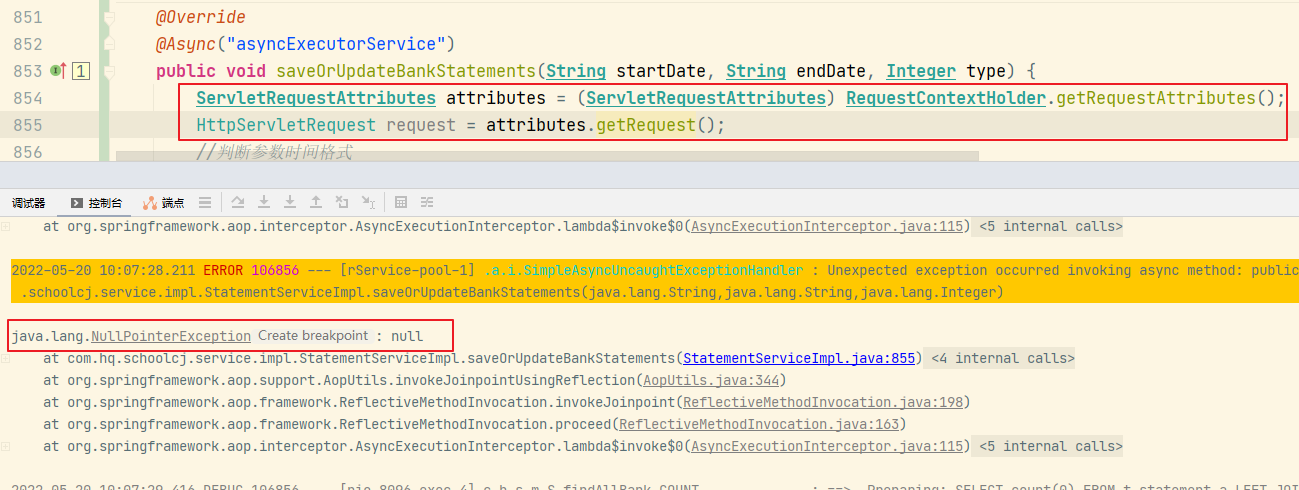分析
- 在某些场景下我们希望在Service业务逻辑层获取到当前的
HttpServletRequest对象,一个简单直接的处理办法是HttpServletRequest对象通过方法参数传递到下一层,但是这种办法并不灵活,我们需要一种更为通用和灵活的方式。 - 对于这种需要在整个线程内使用的对象,我们很容易想到借助于
ThreadLocal对象,是的我们可以使用该组件。然后再借助于RequestListener监听器,通过实现该接口在请求进入时将当前的HttpServletRequest添加到特定的ThreadLocal容器中,然后再后面的业务层中就可以直接在当前特定的ThreadLocal容器中获取HttpServletRequest对象。 - 上面所描述的功能我们可以通过以下几种方式去实现
- 利用
ServletRequestListener实现 - 利用
Filter实现 - 利用拦截器实现
- 利用
对于上面所描述的功能,需要特别注意的一点是只能在一个线程中去实现该功能。在很多的场景下,在接收到请求之后,我们会通过异步子线程的方式去分担任务处理以此提高处理效率。那么如果在异步子线程中去获取
ThreadLocal中的对象又会存在问题了,需要我们特别注意。常见的实现方式
下面几种实现原理都是一样的,使用一个
ThreadLocal存储当前HttpServletRequest请求对象,然后后面在service或者dao层直接通过该静态ThreadLocal对象get()获取即可。1. 利用ServletRequestListener实现
```java public class RequestHolder implements ServletRequestListener {
//存储HttpServletRequest的线程容器 private static ThreadLocal
httpServletRequestHolder = new ThreadLocal<HttpServletRequest>();
@Override public void requestInitialized(ServletRequestEvent requestEvent) {
// 绑定到当前线程HttpServletRequest request = (HttpServletRequest) requestEvent.getServletRequest();httpServletRequestHolder.set(request);
}
@Override public void requestDestroyed(ServletRequestEvent requestEvent) {
//移除本次请求对象httpServletRequestHolder.remove();
}
public static HttpServletRequest getHttpServletRequest() {
return httpServletRequestHolder.get();
}
}
<a name="VxpCg"></a>### 2. 利用Filter实现```javapublic class RequestHolder implements Filter {//存储HttpServletRequest的线程容器private static ThreadLocal<HttpServletRequest> httpServletRequestHolder =new ThreadLocal<HttpServletRequest>();@Overridepublic void init(FilterConfig filterConfig) throws ServletException {}@Overridepublic void doFilter(ServletRequest request, ServletResponse response,FilterChain chain) throws IOException, ServletException {// 绑定到当前线程httpServletRequestHolder.set((HttpServletRequest) request);try {chain.doFilter(request, response);} catch (Exception e) {throw e;} finally {//移除本次请求对象httpServletRequestHolder.remove();}}@Overridepublic void destroy() {}public static HttpServletRequest getHttpServletRequest() {return httpServletRequestHolder.get();}}
3. 利用拦截器实现
public class RequestHolder extends HandlerInterceptorAdapter {//存储HttpServletRequest的线程容器private static ThreadLocal<HttpServletRequest> httpServletRequestHolder =new ThreadLocal<HttpServletRequest>();@Overridepublic boolean preHandle(HttpServletRequest request, HttpServletResponse response, Object handler)throws Exception {// 绑定到当前线程httpServletRequestHolder.set(request);return true;}@Overridepublic void afterCompletion(HttpServletRequest request, HttpServletResponse response,Object handler, Exception ex)throws Exception {//移除本次请求对象httpServletRequestHolder.remove();}public static HttpServletRequest getHttpServletRequest() {return httpServletRequestHolder.get();}}
RequestContextHolder原理分析
类似的功能,在SpringMVC中就有开箱即用的实现。代码是:
HttpServletRequest request = (ServletRequestAttributes) RequestContextHolder.getRequestAttributes()).getRequest();
RequestContextHolder类分析
public abstract class RequestContextHolder {//存储了当前线程的RequestAttributes对象容器private static final ThreadLocal<RequestAttributes> requestAttributesHolder = new NamedThreadLocal("Request attributes");//存储科可继承父线程的RequestAttributes对象容器private static final ThreadLocal<RequestAttributes> inheritableRequestAttributesHolder = new NamedInheritableThreadLocal("Request context");//清理上次线程资源public static void resetRequestAttributes() {requestAttributesHolder.remove();inheritableRequestAttributesHolder.remove();}//处理当前请求对象,赋值到容器存储中public static void setRequestAttributes(@Nullable RequestAttributes attributes, boolean inheritable) {if (attributes == null) {resetRequestAttributes();} else if (inheritable) {//是否可继承父线程请求对象inheritableRequestAttributesHolder.set(attributes);requestAttributesHolder.remove();} else {requestAttributesHolder.set(attributes);inheritableRequestAttributesHolder.remove();}}//尝试获取当前请求对象属性@Nullablepublic static RequestAttributes getRequestAttributes() {RequestAttributes attributes = (RequestAttributes)requestAttributesHolder.get();if (attributes == null) {attributes = (RequestAttributes)inheritableRequestAttributesHolder.get();}return attributes;}//获取当前请求对象属性public static RequestAttributes currentRequestAttributes() throws IllegalStateException {RequestAttributes attributes = getRequestAttributes();if (attributes == null) {if (jsfPresent) {attributes = RequestContextHolder.FacesRequestAttributesFactory.getFacesRequestAttributes();}//如果不是HTTP请求则可能抛出以下错误if (attributes == null) {throw new IllegalStateException("No thread-bound request found: Are you referring to request attributes outside of an actual web request, or processing a request outside of the originally receiving thread? If you are actually operating within a web request and still receive this message, your code is probably running outside of DispatcherServlet: In this case, use RequestContextListener or RequestContextFilter to expose the current request.");}}return attributes;}}
org.springframework.web.servlet.FrameworkServlet#processRequest方法

processRequest方法在每次请求时都会被调用执行。如上图所示各个请求类型都会去调用该方法。
protected final void processRequest(HttpServletRequest request, HttpServletResponse response) throws ServletException, IOException {//获取RequestContextHolder当前请求对象,可能为空RequestAttributes previousAttributes = RequestContextHolder.getRequestAttributes();//对HttpServletRequest进行包装,包装成ServletRequestAttributes对象ServletRequestAttributes requestAttributes = this.buildRequestAttributes(request, response, previousAttributes);WebAsyncManager asyncManager = WebAsyncUtils.getAsyncManager(request);asyncManager.registerCallableInterceptor(FrameworkServlet.class.getName(), new FrameworkServlet.RequestBindingInterceptor());//初始化本次请求对象,这里主要就是更新当前RequestContextHolder存储的线程请求对象this.initContextHolders(request, localeContext, requestAttributes);try {this.doService(request, response);}}
org.springframework.web.servlet.FrameworkServlet#initContextHolders方法
调用RequestContextHolder.setRequestAttributes()方法,把requestAttributes对象放入。this.threadContextInheritable默认是false。
即把HttpServletRequest的封装对象ServletRequestAttributes与当前线程绑定。
private void initContextHolders(HttpServletRequest request, @Nullable LocaleContext localeContext, @Nullable RequestAttributes requestAttributes) {if (localeContext != null) {LocaleContextHolder.setLocaleContext(localeContext, this.threadContextInheritable);}if (requestAttributes != null) {RequestContextHolder.setRequestAttributes(requestAttributes, this.threadContextInheritable);}}
异步子线程应用,继承父线程请求对象
如果此时我们在Service层方法中添加了@Async注解,进行异步处理。结果如下图所示,无法获取请求对象抛出空指针异常。
方法一:手动在父线程设置可继承属性,子线程复用父线程请求对象
RequestContextHolder.setRequestAttributes(RequestContextHolder.getRequestAttributes(),true);设置可继承父请求属性。
@Autowiredprivate MyService myService;@GetMapping("/get")public String get(){RequestContextHolder.setRequestAttributes(RequestContextHolder.getRequestAttributes(),true);myService.process();return "OK";}
方法二:配置线程池
上述方式相对来说需要在每次异步操作时进行手动设置不是很方便,而对于一般的异步处理都是通过线程池分配子线程进行处理的,所以我们也可以通过配置线程池的方式来完成该功能需求。
/*** 线程处理器,在分配线程时将父线程的RequestContextHolder.currentRequestAttributes();* 传递给子线程,注意这里的可能会出现一个异常,比如当前请求不是HTTP请求,即分配一个无HTTP参与的任务,* 比如MQ任务,一般的计算任务等等,但是不会影响任务的执行* @author zhangyu* @date 2022/1/27 14:48**/public class ContextAwarePoolExecutor extends ThreadPoolTaskExecutor {@Overridepublic <T> Future<T> submit(Callable<T> task) {RequestAttributes requestAttributes=null;try{requestAttributes = RequestContextHolder.currentRequestAttributes();}catch (IllegalStateException e){}return super.submit(new ContextAwareCallable(task,requestAttributes ));}@Overridepublic <T> ListenableFuture<T> submitListenable(Callable<T> task) {RequestAttributes requestAttributes=null;try{requestAttributes = RequestContextHolder.currentRequestAttributes();}catch (IllegalStateException e) {}return super.submitListenable(new ContextAwareCallable(task,requestAttributes));}}
/*** 线程处理* @author zhangyu* @date 2022/1/27 14:48**/public class ContextAwareCallable<T> implements Callable<T> {private Callable<T> task;private RequestAttributes context;public ContextAwareCallable(Callable<T> task, RequestAttributes context) {this.task = task;this.context = context;}@Overridepublic T call() throws Exception {if (context != null) {RequestContextHolder.setRequestAttributes(context);}try {return task.call();} finally {RequestContextHolder.resetRequestAttributes();}}}
配置线程池:
/*** 线程池配置、启用异步***/@EnableAsync(proxyTargetClass = true)@Configurationpublic class AsycTaskExecutorConfig {@Beanpublic TaskExecutor taskExecutor() {//自定义线程池对象ThreadPoolTaskExecutor taskExecutor = new ContextAwarePoolExecutor();taskExecutor.setCorePoolSize(50);taskExecutor.setMaxPoolSize(100);return taskExecutor;}}
经过测试可以发现可以在子线程中正常获取HTTP请求信息
参考文档
Web应用中Service层获取request对象 | RequestContextHolder的使用
使用@async 注解,导致访问RequestContextHolder获取request为空
RequestContextHolder实践整理

